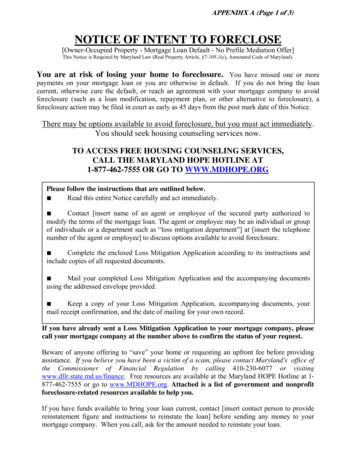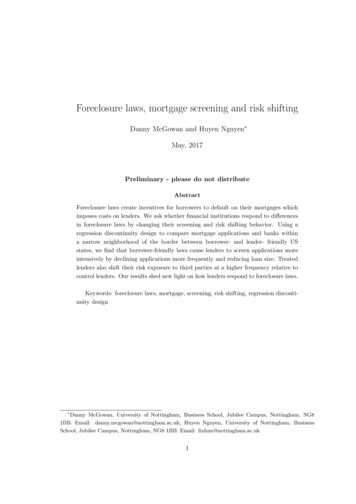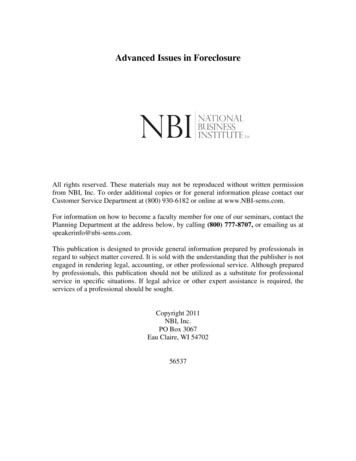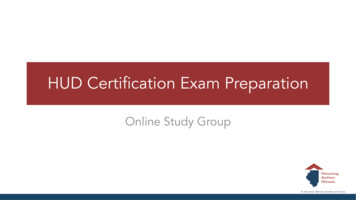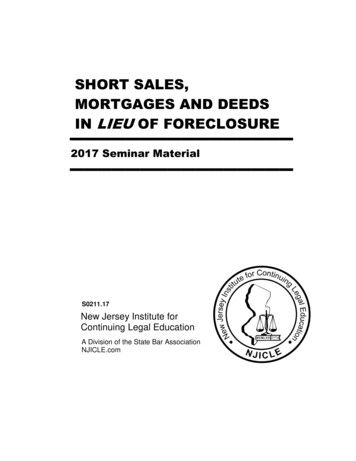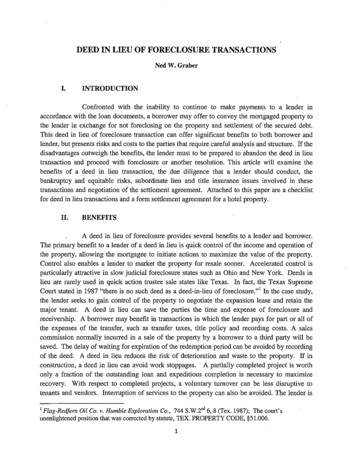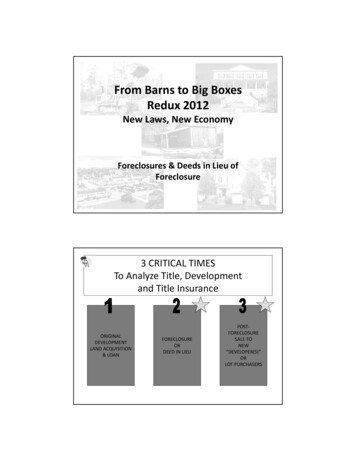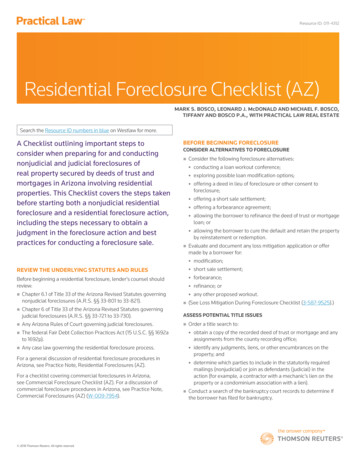
Transcription
Resource ID: 011-4312Residential Foreclosure Checklist (AZ)MARK S. BOSCO, LEONARD J. McDONALD AND MICHAEL F. BOSCO,TIFFANY AND BOSCO P.A., WITH PRACTICAL LAW REAL ESTATESearch the Resource ID numbers in blue on Westlaw for more.A Checklist outlining important steps toconsider when preparing for and conductingnonjudicial and judicial foreclosures ofreal property secured by deeds of trust andmortgages in Arizona involving residentialproperties. This Checklist covers the steps takenbefore starting both a nonjudicial residentialforeclosure and a residential foreclosure action,including the steps necessary to obtain ajudgment in the foreclosure action and bestpractices for conducting a foreclosure sale.BEFORE BEGINNING FORECLOSURECONSIDER ALTERNATIVES TO FORECLOSURE Consider the following foreclosure alternatives:zzconducting a loan workout conference;zzexploring possible loan modification options;zzoffering a deed in lieu of foreclosure or other consent toforeclosure;zzoffering a short sale settlement;zzoffering a forbearance agreement;zzzzallowing the borrower to refinance the deed of trust or mortgageloan; orallowing the borrower to cure the default and retain the propertyby reinstatement or redemption. Evaluate and document any loss mitigation application or offermade by a borrower for:REVIEW THE UNDERLYING STATUTES AND RULESBefore beginning a residential foreclosure, lender’s counsel shouldreview: Chapter 6.1 of Title 33 of the Arizona Revised Statutes governingnonjudicial foreclosures (A.R.S. §§ 33-801 to 33-821). Chapter 6 of Title 33 of the Arizona Revised Statutes governingjudicial foreclosures (A.R.S. §§ 33-721 to 33-730). Any Arizona Rules of Court governing judicial foreclosures. The federal Fair Debt Collection Practices Act (15 U.S.C. §§ 1692azzmodification;zzshort sale settlement;zzforbearance;zzrefinance; orzzany other proposed workout. (See Loss Mitigation During Foreclosure Checklist (3-587-9525).)ASSESS POTENTIAL TITLE ISSUES Order a title search to:zzto 1692p). Any case law governing the residential foreclosure process.zzFor a general discussion of residential foreclosure procedures inArizona, see Practice Note, Residential Foreclosures (AZ).zzFor a checklist covering commercial foreclosures in Arizona,see Commercial Foreclosure Checklist (AZ). For a discussion ofcommercial foreclosure procedures in Arizona, see Practice Note,Commercial Foreclosures (AZ) (W-009-7954). 2018 Thomson Reuters. All rights reserved.obtain a copy of the recorded deed of trust or mortgage and anyassignments from the county recording office;identify any judgments, liens, or other encumbrances on theproperty; anddetermine which parties to include in the statutorily requiredmailings (nonjudicial) or join as defendants (judicial) in theaction (for example, a contractor with a mechanic’s lien on theproperty or a condominium association with a lien). Conduct a search of the bankruptcy court records to determine ifthe borrower has filed for bankruptcy.
Residential Foreclosure Checklist (AZ) Perform an active military service check on the borrower todetermine if the borrower is in the military and afforded specialprotections in a foreclosure action (see Practice Note, Complying withConsumer Protections for Military Servicemembers) (0-572-0565). Consider paying off any superior lien holders, such as:zzoutstanding municipal liens;zzreal property taxes owed on the mortgage property; andzzhomeowner association liens.ESTABLISH POSSESSION OF THE ORIGINAL LOAN DOCUMENTS Obtain the original loan documents (deed of trust or mortgage,promissory note or bond, and assignments, if any), including theloan application, survey, and lender’s title insurance policy. Confirm the current lender’s name and the date each deed of trustor mortgage document was issued or assigned, or both. If the original promissory note or any assignments of the deed oftrust or mortgage were lost or destroyed, obtain copies of eachdocument. Prepare a lost note affidavit for signature by the servicer if thepromissory note has been lost or destroyed. Obtain certified copies of any assignment or other recordeddocument from the recorder’s office certifying that the documentsare true and accurate. Obtain an endorsement of the note and an assignment of the deedof trust or mortgage if the foreclosing party is not:zzthe original lender; orzzthe lender of record.ASSESS THE STATUE OF LIMITATIONS Review the deed of trust or mortgage and promissory note todetermine:zzzzthe maturity date; andany written extensions for final payment provided in any writteninstrument. Consider that residential foreclosure actions must begin withinsix years of the borrower’s default date if the loan has beenaccelerated (A.R.S. § 12-548). Carefully review the statute of limitations issues on a loan-by-loanbasis, including:zzzzzza thorough review of the loan history to determine if the debt isstill viable;the various tolling events recognized in Arizona, includingbankruptcy, deceleration and loss mitigation; andthe continuous breach theory, with each month being a newand independent default for the purposes of the statute oflimitations if the lender has not accelerated the debt. A cancellation of trustee’s sale by itself is however not sufficientto revoke a lender’s prior acceleration of a loan and must containexpress language revoking the prior acceleration.CONSIDER MAILING A DEMAND LETTER Review the promissory note and deed of trust (or mortgage, asapplicable) for any contractually required notice requirements.2 If no notice is contractually required, consider mailing a demandletter to the borrower, including:zzthe loan’s terms;zza description of the default; andzza statement that the trustee intends to strictly enforce the loan’sterms if the borrower does not cure the default.CONFIRM COMPLIANCE WITH CONSUMER FINANCIALPROTECTION BUREAU REGULATIONS Consider that the Consumer Financial Protection Bureau (CFPB)imposes additional limitations on most lenders when seeking toforeclose a loan secured by residential real property. If the lender is subject to the CFPB regulations, ensure that thelender waits at least 120 days after the residential loan becomesdelinquent before:zzzzbeginning the nonjudicial foreclosure process by recording anotice of sale; orfiling a civil complaint to begin the judicial foreclosure process.(12 C.F.R. § 1024.41(f).)For more information on CFPB requirements during a foreclosure,see Practice Notes, Summary of the Dodd-Frank Act: ConsumerFinancial Protection: Subtitle A: Consumer Financial ProtectionBureau (2-543-6265) and Residential Foreclosures (AZ): Restrictionson Consumer Debt Collection (W-009-7954).NONJUDICIAL FORECLOSURERECORD A SUBSTITUTION OF TRUSTEE Appoint a substitute trustee if the trustee named in the deed of trustis unqualified, unwilling, or unable to conduct the foreclosure sale. Record the substitution of trustee in the county where the realproperty is located.For more information on recording a substitution of trustee, seePractice Note, Residential Foreclosures (AZ): Substitution of Trustee(W-009-7954).RECORD THE NOTICE OF SALE Prepare a notice of sale using the statutory form. Schedule the sale date at least 91 days after the date the trusteerecords the notice of sale. Include the following statement in the notice of sale’s firstparagraph, in bold-faced and capitalized type:zz“NOTICE! IF YOU BELIEVE THERE IS A DEFENSE TO THETRUSTEE SALE OR IF YOU HAVE AN OBJECTION TO THETRUSTEE SALE, YOU MUST FILE AN ACTION AND OBTAINA COURT ORDER PURSUANT TO RULE 65, ARIZONARULES OF CIVIL PROCEDURE, STOPPING THE SALE NOLATER THAN 5:00 P.M. MOUNTAIN STANDARD TIME OFTHE LAST BUSINESS DAY BEFORE THE SCHEDULED DATEOF THE SALE, OR YOU MAY HAVE WAIVED ANY DEFENSESOR OBJECTIONS TO THE SALE. UNLESS YOU OBTAIN ANORDER, THE SALE WILL BE FINAL.” Record the notice of sale in the county where the real property islocated.(A.R.S. § 33-808(C), (D).) 2018 Thomson Reuters. All rights reserved.
Residential Foreclosure Checklist (AZ)For more information discussing the notice of sale requirements, seePractice Note, Residential Foreclosures (AZ): Record the Notice ofSale (W-009-7954).zzzzthe superior court for the county where the property is located; orthe trustee’s office, if the office is located in the county where theproperty is located.MAIL THE NOTICE OF SALE(A.R.S. § 33-808(B).) Within five days after recording the notice of sale, mail a plain copy Offer the property for cash sale by public auction.of the notice to all parties listed in the deed of trust other than thetrustee, by certified or registered mail with postage prepaid (A.R.S.§ 33-809(C)). Mail a copy of the notice of sale, including the recording date,within 30 days after recording:zzzzto all parties with a recorded interest in the property, by certifiedor registered mail, with postage prepaid; andto the property, by first-class mail, if the property includes asingle-family residence.(A.R.S. § 33-809(B).) Include a statement of breach with the notice of sale mailing(A.R.S. § 33-809(C)). Mail a copy of the notice of sale to the IRS at least 25 days beforethe sale date if the title review reveals a federal tax lien (26 U.S.C.§ 7425(c)(1)).For more information on the mailing requirements, see Practice Note,Residential Foreclosures (AZ): Mail the Notice of Sale (W-009-7954)and Mail a Statement of Breach (W-009-7954).PUBLISH AND POST THE NOTICE OF SALE Publish the notice of sale in a newspaper of general circulation inthe county where the real property is located:zzzzat least once per week for at least four consecutive weeks; andzzsale (A.R.S. § 33-810(A)). Ensure that the successful bidder pays the balance of thesuccessful bid amount in cash or other form acceptable to thetrustee by 5:00 p.m. on the first business day following the saledate. If the successful bidder is the beneficiary, the property reverts tothe beneficiary with the full credit bid amount.For more information on conducting the sale, see Practice Note,Residential Foreclosures (AZ): Conducting the Sale (W-009-7954).COMPLETE THE POST-SALE REQUIREMENTS Execute and deliver the trustee’s deed to the successful bidderwithin seven days of payment of the full bid amount (A.R.S.§ 33-811(B)). Take possession of the real property:zzzzin a conspicuous place on the real property (or at a gate or otherimpediment if the trustee cannot access the property) at least20 days before the sale date; andproperty is occupied (a so-called cash-for-keys delivery).zzzzzz(A.R.S. § 33-808(A)(3-4).)zz Determine if the property is in need of protection or preservation. Apply for the court to appoint a receiver with the superior court forthe county where the real property is located.For more information on appointing a receiver, see Practice Note,Residential Foreclosures (AZ): Consider Appointing a Receiver(W-009-7954).CONDUCT THE TRUSTEE’S SALE Make the trustee’s actual bid amount or good faith estimate of thecredit bid amount available between 9:00 a.m. and 5:00 p.m. onthe last business day before the sale (A.R.S. § 33-809(F)). Hold the sale between 9:00 a.m. and 5:00 p.m. on a business day at:zzthe subject property; 2018 Thomson Reuters. All rights reserved.after completing a forcible entry and detainer action (eviction), ifthe property is occupied. Distribute the sale proceeds in the following order of priority:at the designated spot for postings in the superior court for thecounty where the real property is located.CONSIDER APPOINTING A RECEIVERimmediately, if the property is vacant; or Consider negotiating voluntary delivery of possession if thewith the final publication date not fewer than ten days before thesale date. Post a copy of the notice of sale:zz Ensure that bidders deposit 10,000 with the trustee before thezzto reimburse the costs and expenses of exercising the powerof sale, including paying the trustee’s fees and reasonableattorneys’ fees;to pay the loan balance;to pay all other indebtedness secured by the deed of trust andactually paid by the beneficiary before the sale. It is at thislevel of payment that it is determined whether a surplus ordeficiency exists. If there are funds remaining after satisfying theindebtedness, a surplus exists. If there is a surplus, the trusteemust send written notice of the surplus to the trustor at eachof the trustor’s known addresses via certified mail, the cost ofwhich may be deducted from the surplus (A.R.S. § 33-812(B));the trustee at its discretion may directly pay any condominiumassociation or planned community association having asubordinate lien; andthe trustee at its discretion may directly pay any remainder tojunior lienholders in the order of priority that existed at the timeof the sale.(A.R.S. § 33-812(A).) The trustee at its discretion may choose to deposit any remainingproceeds with the county treasurer within 90 days following thesale date by:zzzzfiling a complaint with the superior court, naming the countytreasurer as the defendant; andmailing a certified copy of the complaint to the county treasurerand all persons who received the notice of sale.3
Residential Foreclosure Checklist (AZ)(A.R.S. § 33-812 (C), (D), and (G) and see Mail the Notice of Sale(W-011-4312).) Complete a declaration of additional funds received to reportany payments made under a private mortgage insurance policyreceived after the sale date.For more information on the post-sale requirements, see PracticeNote, Residential Foreclosures (AZ): Post-Sale Requirements(W-009-7954).JUDICIAL FORECLOSUREPREPARE THE FORECLOSURE COMPLAINT Prepare the foreclosure complaint, identifying the necessaryparties, including:For more information on preparing the foreclosure complaint, seePractice Note, Residential Foreclosures (AZ): File a ForeclosureComplaint (W-009-7954).FILE AND SERVE THE FORECLOSURE COMPLAINT File the foreclosure complaint with the superior court for thecounty where the real property is located (A.R.S. § 33-721). Serve a copy of the complaint on the other named parties to theaction (Ariz. R. Civ. P. 4.1 and 4.2 and see State Q&A, Commencingan Action: Arizona: Question 12 (6-567-2905)). Record a notice of lis pendens with the recorder’s office in thecounty where the real property is located (A.R.S. § 12-1191(A)).FILE AN ANSWER: DEFENDANT (OPTIONAL)zzthe mortgagor (borrower);zzthe mortgagor’s successors and assigns, if any;foreclosure, including:the real property’s owner, if different from the borrower (forexample, a guarantor who pledged the property as collateral fora loan);zzthe full payment of the mortgage;zzthe mortgage’s release or satisfaction;zzchallenging the lien’s validity; andzzzzany party with a recorded interest in the real property; andzzany junior lien holders.(Ariz. R. Civ. P. 19(a).) To assist in identifying the necessary parties, consider obtaining:zzzza litigation report from a litigation support services company;anda litigation guarantee from a reputable title company.Allege the Minimum Facts and Request the Appropriate Relief Determine whether the defendant has a valid defense tozzthe inability to fulfill a condition of the mortgage due toaccident, mistake, or fraud. File the answer within 20 days after receiving service of thesummons and complaint, if served in Arizona.For a more detailed discussion of the steps for filing pleadingsin Arizona, see State Q&As, Commencing an Action: Arizona(6-567-2905) and Responding to a Complaint: Arizona(W-000-6712). Describe each party’s interest in the real property.FILE FOR A DEFAULT JUDGMENT OR MOTIONFOR SUMMARY JUDGMENT Describe the mortgage or deed of trust and the secured File a motion for default judgment if the borrower fails to respondindebtedness. Describe the default. Include facts establishing the lender’s compliance with statutory orcontractual pre-foreclosure requirements, if any. Request relief from the court that:zzforecloses the mortgage or deed of trust;zzestablishes the redemption period; andzzauthorizes a credit bid at the foreclosure sale. Ensure that all requests for relief include facts supporting eachspecial relief.or appear (Ariz. R. Civ. P. 55). File a motion for summary judgment if the borrower filesa response but does not dispute the material facts(Ariz. R. Civ. P. 56).EXECUTE ON THE FORECLOSURE SALE AFTER JUDGMENT Obtain a writ of execution (writ) directing the county sheriff to levyon and sell the real property (A.R.S. § 12-1551(A)). Ensure that the county sheriff:zzAttach the Exhibits to the Complaint Attach exhibits to the complaint, including copies of:zzthe vesting deed;zzthe signed promissory note;zzthe recorded deed of trust or mortgage;zzany recorded assignments of the mortgage or deed of trust;zzany substitution of trustee; andzzany other recorded liens or interests in the real property. Review the Arizona Rules of Civil Procedure and local guidance forany format and content requirements.4zzzzposts a notice of sale in at least three public places, including ator near the door of the superior court for the county where thereal property is located;publishes the notice of sale in a newspaper for three consecutiveweeks before the sale date; andendorses the writ and records it with the county recorder (A.R.S.§ 12-1559(1)).(A.R.S. § 12-1621(A)(3).) Ensure that the county sheriff conducts the foreclosure sale:zzzzat or near the courthouse door of the superior court for thecounty where the real property is located (A.R.S. § 12-1621(C));between the hours of 10:00 a.m. and 4:00 p.m.; and 2018 Thomson Reuters. All rights reserved.
ResidentialResidential ForeclosureForeclosure ChecklistChecklist (AZ)(AZ)zzas an auction of the property to the highest bidder (A.R.S.§ 12-1622(A)).DISBURSE THE SALE PROCEEDS Ensure the sheriff disburses the sale proceeds in the followingorder:zzzzzzto reimburse the costs incurred in conducting the sale;to the foreclosing lender until its award in the court judgment issatisfied;to other amounts secured by the mortgage or deed of trustforeclosed;zzto the junior lienholders in order of priority; andzzany remainder to the debtor.(A.R.S. § 33-727(A).)DETERMINE THE RIGHT OF REDEMPTION Consider that the borrower has a right of redemption allowingthe borrower to retain the property after a foreclosure sale. Theborrower’s applicable redemption period is either:zzzz30 days from the date of the sale if the property was abandonedand not primarily used for grazing or agricultural purposes; orsix months from the sale date if the property was occupied orused primarily for grazing or agricultural purposes.(A.R.S. § 12-1282.)Redeem the Property: Borrower Pay the following to redeem the property:zzthe purchase price;zzan additional fee equal to 8% of the purchase price;zzzzthe amount of any assessments or taxes paid by the purchaser;andCLEAR TITLE AND OBTAIN POSSESSION OF THE PROPERTY Within 30 days following the end of the applicable redemptionperiod, ensure that the county sheriff:zzrecords the sheriff’s deed with the county recorder;zzexecutes a duplicate sheriff’s deed; andzzdelivers the duplicate sheriff’s deed to the purchaser orredemptioner, as applicable.(A.R.S. § 12-1286.) Start and complete a forcible entry and detainer action to obtainpossession if the property is occupied (see Complete the Post-SaleRequirements).FILE FOR A DEFICIENCY JUDGMENT (OPTIONAL) In a nonjudicial foreclosure, file an action with the superiorcourt within 90 days following the sale date unless a deficiencyjudgment is prohibited because:zzzzthe deed of trust forbids recovery of any deficiency (A.R.S.§ 33-814(F)); orthe property is 2.5 acres or less in total size and used only for asingle-family or single two-family dwelling (A.R.S. § 33-814(G)). In a judicial foreclosure, file a motion for a deficiency judgmentunless the deficiency is prohibited because:zzzzthe foreclosed mortgage was a purchase money mortgage(A.R.S. § 33-729(A)); orthe action for the deficiency was not personally served on thedebtor and the debtor did not appear in the deficiency action(A.R.S. § 33-727(A)).For more information on deficiency judgments in Arizona, seePractice Note, Residential Foreclosures (AZ): Deficiency Judgments(W-009-7954).interest on the amounts paid by the purchaser.(A.R.S. § 12-1285.)ABOUT PRACTICAL LAWPractical Law provides legal know-how that gives lawyers a better startingpoint. Our expert team of attorney editors creates and maintains thousands ofup-to-date, practical resources across all major practice areas. We go beyondprimary law and traditional legal research to give you the resources needed topractice more efficiently, improve client service and add more value.If you are not currently a subscriber, we invite you to take a trial of our onlineservices at legalsolutions.com/practical-law. For more information or toschedule training, call 1-800-733-2889 or e-mail referenceattorneys@tr.com.08-18 2018 Thomson Reuters. All rights reserved. Use of Practical Law websites and services is subject to theTerms of Use tatic/agreement/westlaw-additional-terms.pdf)and Privacy Policy (https://a.next.westlaw.com/Privacy).5
Prepare a lost note affidavit for signature by the servicer if the promissory note has been lost or destroyed. Obtain certified copies of any assignment or other recorded document from the recorder's office certifying that the documents are true and accurate. Obtain an endorsement of the note and an assignment of the deed



